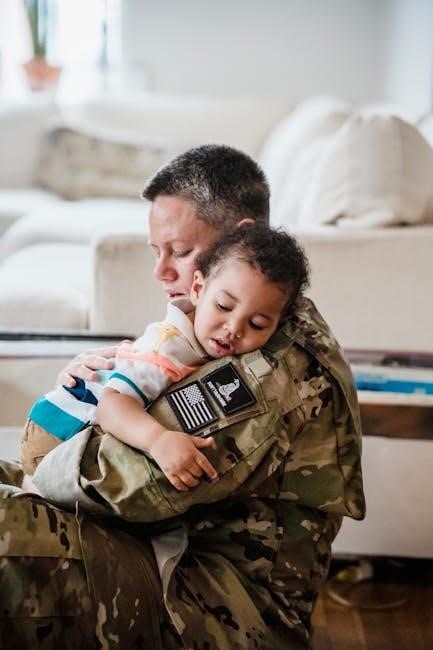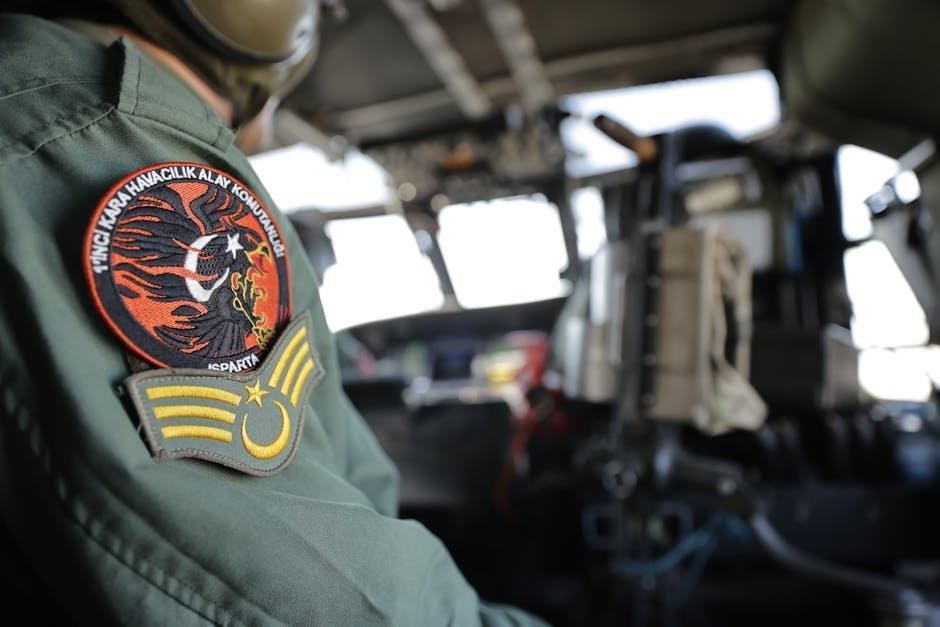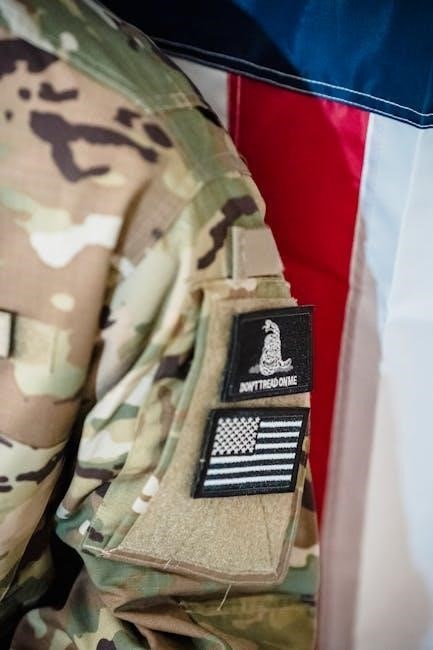Military patches are a key element of uniforms, serving to identify units, ranks, and achievements while preserving military tradition․ This guide provides a comprehensive overview of patch placement rules, regulations, and best practices across different military branches and uniform types, ensuring proper representation and adherence to official standards․
Overview of Military Patches
Military patches are embroidered emblems worn on uniforms to identify units, ranks, and specializations․ They symbolize achievements, honor, and adherence to military tradition․ Patches vary by branch and include shoulder sleeve insignia, unit patches, rank insignia, and commemorative designs․ Made from fabric or leather, they are sewn or ironed on, often featuring symbols, colors, and mottos specific to the unit․ Proper placement and maintenance are essential for uniformity and respect for military heritage․
Importance of Proper Patch Placement
Proper patch placement is crucial for maintaining uniformity and respect within military traditions․ It ensures identification, reflects unit pride, and signifies achievements․ Incorrect placement can lead to disciplinary actions and undermine professionalism․ Adhering to guidelines preserves the integrity of military insignia, fostering cohesion and discipline․ Uniformity in patch placement is non-negotiable, reflecting the values of precision and order upheld by military organizations․ Accuracy in placement is a mark of respect for both the individual and their unit’s legacy․
History of Military Patches
Military patches trace their origins to World War I, initially used for unit identification․ Over time, they evolved to represent achievements, honor, and esprit de corps, becoming a lasting tradition․
Origins and Evolution
Military patches originated in World War I as simple cloth insignia to distinguish units․ Over time, they evolved to signify rank, achievements, and branch affiliation․ By World War II, patches became standardized, incorporating intricate designs and colors․ Today, they serve as symbols of pride, heritage, and service, with precise placement guidelines to maintain uniformity and respect for tradition․
Historical Significance in Different Conflicts
Patches played a crucial role in identifying units during World War I and World War II, preventing friendly fire and fostering unit cohesion․ In Vietnam, patches reflected specialized skills and missions․ Modern conflicts continue this tradition, with patches symbolizing deployments, operations, and honors․ Each design tells a story, honoring sacrifices and achievements, making them vital historical artifacts and sources of military pride․
Military Branches and Their Patch Placement Guidelines
Each military branch has unique patch placement regulations, ensuring uniformity and adherence to tradition․ Guidelines vary across Army, Navy, Coast Guard, Air Force, and Marine Corps uniforms․
U․S․ Army Patch Placement
U․S․ Army patches are placed on uniforms with precision, following specific regulations․ Unit patches are worn on the left shoulder, while combat patches are on the right․ Name and rank insignia are centered on the chest․ Large insignia, like unit crests, are placed on the back․ Combat uniforms follow ACU guidelines, with subdued colors, whereas dress uniforms display full-color patches․ Proper placement ensures uniformity and adherence to military tradition․
U․S․ Navy and Coast Guard Patch Placement
In the U․S․ Navy and Coast Guard, patches are strategically placed to denote rank, unit, and service․ Shoulder patches indicate command or unit affiliation, with the Navy placing them on the left shoulder and the Coast Guard on the right․ Rank insignia is displayed on the collar, while name tags are centered above the right breast pocket․ The American flag patch is worn on the right shoulder․ Dress and service uniforms follow specific guidelines, with combat uniforms often omitting patches for operational safety․
U;S․ Air Force Patch Placement
In the U․S․ Air Force, patches are worn on designated areas of the uniform to signify rank, unit, and service․ The American flag patch is positioned on the right shoulder of the Operational Camouflage Pattern (OCP) uniform․ Unit insignia and rank are displayed on the chest, with unit patches on the left and right sides․ Rank insignia is centered on the chest, above the name tape, which is placed above the right chest pocket․ The U․S․ Air Force tag is worn above the left chest pocket, ensuring proper alignment and compliance with regulations․
U․S․ Marine Corps Patch Placement
In the U․S․ Marine Corps, patches are strategically placed to reflect service identity and achievements․ The American flag patch is sewn on the right shoulder of utility uniforms․ Unit insignia is positioned on the left shoulder, while rank insignia is centered on the collar․ Name tapes and rank tapes are worn on the chest, with the name tape on the right and rank tape on the left․ Combat uniforms follow subdued color schemes, ensuring consistency and adherence to Corps regulations․

Uniform Types and Patch Placement
Uniform types vary by purpose, with combat, dress, and flight suits each having specific patch placement rules to ensure proper representation and adherence to regulations․
Combat Uniforms
Combat uniforms prioritize functionality while maintaining regulation adherence․ Patches on these uniforms, such as unit insignia, rank, and the American flag, are strategically placed to ensure visibility and identification․ The left shoulder typically features the unit patch, while the right shoulder may display combat or special skill badges․ Rank insignia is often positioned on the chest or sleeves, and the flag patch is usually placed on the right sleeve․ These placements balance practicality with the need for clear identification and esprit de corps, adhering to strict military guidelines to maintain uniformity and professionalism in operational settings․
Dress Uniforms
Dress uniforms are formal attire worn during ceremonies and official events, requiring precise patch placement to reflect professionalism and tradition․ Unit insignia, rank, and the American flag are positioned with meticulous care to maintain uniformity․ The left shoulder typically features the unit patch, while rank insignia is prominently displayed on the chest or sleeves․ The flag patch is often placed on the right shoulder or sleeve, ensuring a balanced and polished appearance that honors military heritage while adhering to strict regulations․
Flight Suits and Specialty Uniforms
Flight suits and specialty uniforms have specific patch placement guidelines to ensure functionality and adherence to regulations․ Unit insignia and rank are typically placed on the chest or sleeves, while the American flag patch is positioned on the right shoulder or upper sleeve․ These uniforms often have limited space, so patches are kept minimal yet meaningful․ Specialized units may have additional patches, but placement must align with branch-specific regulations to maintain uniformity and professionalism․

Specific Patch Placement Rules
Specific patch placement rules ensure uniformity across military branches, with precise guidelines for unit insignia, rank, and flag patches․ Adherence to these rules maintains professionalism and tradition․
American Flag Patch Placement
The American flag patch is worn on military uniforms to signify patriotism and national pride․ On the right shoulder, the flag faces forward as if waving, while on the left, it appears mirrored․ For combat uniforms, subdued colors are used to maintain tactical appearance․ The patch is centered on the sleeve or chest, aligning with uniform guidelines․ Proper placement ensures respect for the flag and adherence to military protocols, avoiding upside-down or reversed displays unless specified for special occasions or unit traditions․
Unit Insignia and Crests
Unit insignia and crests are emblems worn on military uniforms to signify a unit’s identity, history, and achievements․ They are typically placed on the left sleeve for active units or the right sleeve for higher commands․ The design often includes symbols and colors unique to the unit, representing its heritage․ Proper placement ensures uniformity and adherence to military standards, maintaining the tradition of unit pride and esprit de corps among service members․
Rank Insignia Placement
Rank insignia placement varies by military branch and uniform type but generally follows specific guidelines to ensure clarity and proper representation․ In the U․S․ Army, rank insignia is typically worn on the collar or chest, while the Air Force places it on the chest or sleeve․ The Navy and Marine Corps use sleeve or collar placements․ Accurate placement is crucial for visual identification, respect for hierarchy, and maintaining uniformity across all service members, reflecting military professionalism and discipline․

Placement Guides for Common Patches
This section outlines the standardized positions for sleeve, chest, back, and headgear patches, ensuring uniformity and proper representation across all military branches․
Sleeve Patches
Sleeve patches are worn on uniform sleeves to denote unit affiliation, combat service, or special qualifications․ Typically placed on the upper sleeve, they follow specific placement guidelines․ Combat patches are positioned on the right sleeve, while unit insignia are on the left․ Patches should be centered and aligned with the sleeve seam, ensuring a 1/2-inch distance from the shoulder seam․ Proper alignment and spacing are crucial for a professional appearance․ Regulations vary by branch, so adherence is essential for uniformity and correctness․
Chest Patches
Chest patches are worn on the upper chest area of military uniforms to signify rank, qualifications, or awards․ Placement varies by branch and uniform type․ For example, name tapes and rank insignia are centered above the right and left pockets, respectively․ Combat and specialty patches are positioned on the upper left chest, aligning with uniform regulations․ Proper positioning ensures a polished look and compliance with military standards, maintaining uniformity and professional appearance across all personnel․ Precision is key to avoid mismatches․
Back Patches
Back patches are typically reserved for larger insignia or specialty markings on military uniforms․ They are usually centered on the upper back, below the collar, and may signify unit affiliation, morale patches, or commemorative designs․ Placement must adhere to branch-specific regulations to maintain uniformity․ For example, some branches allow larger patches for unit identification, while others restrict size and content․ Proper alignment and secure attachment are essential to uphold professionalism and visual standards․
Headgear Patches
Headgear patches are placed on military caps, typically on the front panel or side, depending on regulations․ They often display unit insignia, rank, or national flags․ Proper alignment is crucial, with the patch centered and secured firmly․ Some branches allow smaller patches on the side, while others prefer larger designs on the front․ Adherence to specific uniform guidelines ensures a professional and standardized appearance across all personnel․ Correct placement reflects discipline and uniformity․
Tools and Techniques for Patch Placement
Military patches are secured using iron-on, sew-on, or hook-and-loop methods․ Proper tools like irons, sewing kits, and patch adhesive ensure durability and correct placement on uniforms․
Iron-On Patches
Iron-on patches are a popular choice for military uniforms due to their ease of application․ These patches have a heat-activated adhesive backing that bonds to fabric when ironed․ To apply, place the patch on the desired location, cover it with a cloth, and iron on medium heat․ Ensure the iron is dry, as steam can damage the adhesive․ Properly applied iron-on patches are durable, but they may not be as long-lasting as sewn-on patches, especially with frequent washing or wear․
Sew-On Patches
Sew-on patches are a traditional and durable option for military uniforms, requiring stitching for secure attachment․ They are commonly used for permanent insignia, such as unit crests or rank, and offer a professional finish․ While more time-consuming to apply than iron-on patches, sew-on patches are less likely to detach over time․ They are ideal for long-term use and can be sewn on using a needle, thread, and basic sewing skills or by a professional tailor for precision․
Hook and Loop Patches
Hook and loop patches are a versatile and convenient option for military uniforms, utilizing a Velcro-like system for easy attachment and removal․ They are widely used for ID patches, morale patches, and tactical gear due to their quick-release functionality․ Made from durable materials like nylon, these patches are designed to withstand rigorous conditions․ Their ease of use makes them ideal for field operations, allowing soldiers to adapt their uniforms without sewing or ironing․ This system has become increasingly popular in modern military applications for its practicality and efficiency․

Common Mistakes to Avoid
- Avoid incorrect patch positioning and improper adhesive use․
- Ensure compliance with uniform regulations and branch-specific guidelines․
- Maintain uniform integrity by avoiding these common errors․
Incorrect Placement Positions
One common mistake is placing patches in incorrect locations, which can undermine uniformity and professionalism․ Ensure patches are positioned according to branch-specific guidelines․ For example, the American flag patch should always be worn on the right shoulder with the stars facing forward․ Incorrect placement of unit insignia or rank patches can lead to disciplinary action․ Always refer to official regulations to avoid misplacement errors that may compromise the integrity of the uniform․ Proper placement is essential for maintaining military standards and respect for tradition․
Improper Use of Adhesives
Using incorrect or excessive adhesives can damage uniforms and cause patches to peel off prematurely․ Avoid using household glue or inappropriate substances, as they may not withstand washing or wear․ Always follow manufacturer instructions for iron-on or sew-on patches․ Using the wrong adhesive can lead to patches peeling off during inspections or in the field, compromising professionalism․ Proper adhesive use ensures patches remain securely in place, maintaining a sharp, military appearance․
Ignoring Uniform Regulations
Ignoring uniform regulations can lead to disciplinary action and undermine professionalism․ Failing to follow guidelines results in improper patch placement, which can create a lack of uniformity and cohesion․ Always adhere to official guidelines for patch placement, as deviations can reflect poorly on both the individual and their unit․ Proper placement ensures a sharp, professional appearance and respect for military tradition and standards․
Military patch placement is a detailed process reflecting tradition, rank, and unit identity․ Proper adherence to regulations ensures professionalism and cohesion across all branches and uniform types․ From combat to dress uniforms, accurate placement signifies respect for military heritage and organizational standards․ Ignoring guidelines can lead to disciplinary actions, underscoring the importance of understanding and following established protocols․ This guide provides essential insights to maintain uniformity and uphold military traditions effectively․